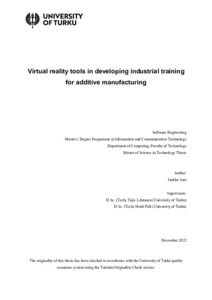Virtual reality tools in developing industrial training for additive manufacturing
Susi, Jaakko (2022-12-07)
Virtual reality tools in developing industrial training for additive manufacturing
Susi, Jaakko
(07.12.2022)
Julkaisu on tekijänoikeussäännösten alainen. Teosta voi lukea ja tulostaa henkilökohtaista käyttöä varten. Käyttö kaupallisiin tarkoituksiin on kielletty.
avoin
Julkaisun pysyvä osoite on:
https://urn.fi/URN:NBN:fi-fe2022122072910
https://urn.fi/URN:NBN:fi-fe2022122072910
Tiivistelmä
Additive manufacturing (commonly known as 3D-printing) is experiencing increasing global popularity in the manufacturing industry. The technology has been adopted by large companies and additive manufacturing services have been outsourced by smaller ones, but first-party adoption of the technology among small and medium-sized enterprises has been slow. Additive manufacturing provides new opportunities for manufacturing but also requires specialized expertise among users of the technology. Studies indicate that modern digital learning techniques such as micro learning and the use of virtual reality and 360° video can provide effective means of learning industrial skills.
The purpose of this thesis was to examine digital learning techniques, 360° video and virtual reality as well as various additive manufacturing technologies in order to produce a virtual reality -based learning application for industrial training of additive manufacturing. It was also necessary to test and validate the effectiveness of the training application and derive future considerations for more advanced iterations. The value of stereoscopic 360° virtual reality video was also examined.
The first version of the training application was successfully completed, and user tests were conducted. A mix of quantitative feedback in the form of a survey, and qualitative feedback in the form of interviews, was gathered from a number of test users. Feedback was overall positive, but some user interface issues, and technical shortcomings were highlighted. Qualitative feedback regarding stereoscopic 360° video indicated the technique to have additional value for learning purposes in virtual reality. The results of these tests will be taken into consideration in the design of a second version of the training application. Topics for further studies were also proposed.
The purpose of this thesis was to examine digital learning techniques, 360° video and virtual reality as well as various additive manufacturing technologies in order to produce a virtual reality -based learning application for industrial training of additive manufacturing. It was also necessary to test and validate the effectiveness of the training application and derive future considerations for more advanced iterations. The value of stereoscopic 360° virtual reality video was also examined.
The first version of the training application was successfully completed, and user tests were conducted. A mix of quantitative feedback in the form of a survey, and qualitative feedback in the form of interviews, was gathered from a number of test users. Feedback was overall positive, but some user interface issues, and technical shortcomings were highlighted. Qualitative feedback regarding stereoscopic 360° video indicated the technique to have additional value for learning purposes in virtual reality. The results of these tests will be taken into consideration in the design of a second version of the training application. Topics for further studies were also proposed.
